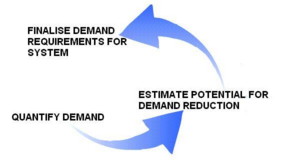

Demand Reduction Considerations
| References |
Introduction
This section will cover potential opportunities for energy demand reduction in large public sector buildings. This forms an essential component of the proposed biomass feasibility assessment schematic. After the overall demand has been estimated it is essential to consider what potential there is to reduce this figure.
| Many demand reduction measures simply represent best practice and are therefore cheaper to implement than purchasing larger plant to satisfy unnecessary energy use. Also measures to reduce demand will encourage those using the building to take more responsibility for their energy use and also act as a visual reminder of similar options which could be employed in the home. |  |
A serious examination of energy use within a building may also identify waste which may be detrimental to thermal comfort. Finally Article 7 of the European Union ‘Energy Performance in Buildings Directive’ stipulates that the energy performance of large buildings is certified and displayed in a prominent place.
This section will take a joint focus. First outlining the general measures which may be applicable to any building in order to reduce energy demand and secondly to focus on specific opportunities for Barony College.
In the context of reducing demand prior to fitting new heating plant it is essential to quantify savings established in order to calculate the size of system required. This section does not offer an in-depth analysis of the actual kW savings achievable to Barony College; this could represent a project in its own right, but establishes an overview of the potential measures which could be implemented and areas for further examination.
Generic Opportunities for Demand Reduction
“Insulation, Glazing, Heating, Ventilation, Lighting and the structure and form of the building itself, work together in a complicated and dynamic way to determine the overall energy performance of the building” 1. As the quote states there are many different factors which, aligned with how the building is used, determine energy demand. Each of these will offer opportunities for improvement, for which energy savings will have to be assessed against costs.
It should be noted that each building will hold its own specific opportunities for improvement and there is no generic solution available. In any demand reduction analysis however the following should be assessed.
Insulation: Additional insulation is a simple method to reduce energy losses. The majority of modern buildings will have adequate insulation in the cavity walls, loft space, under floors and on hot water tanks/distribution pipe-work since it is a requirement of the building regulations. Older buildings however may offer opportunities to either install or increase/renew the insulation present, “Increased insulation levels can be achieved most readily in loft spaces” 1.
Reducing Unwanted Air Infiltration: An optimum level of ventilation is essential in managing thermal comfort and avoiding the build up of airborne pollutants. Examples of these are CO, CO2, moisture, cleaning solvents and organic compounds such as formaldehyde from carpets. However in many cases uncontrolled ventilation can lead to heat losses and poor comfort. This is especially the case in older buildings. Therefore draught proofing and elimination of unplanned openings within the building, which may arise with age/damage, is important.
Double/Triple Glazing: Windows account for a significant percentage of heat loss from a building. It may be possible for double or triple glazing to be fitted (although the energy savings will be smaller in terms of kWh/£ than insulation) and reduce these losses by up to 50% 2.
Further reduction could be achieved through utilising low emissivity coatings on glass. This thin coating sits on the inside of the external pane (of a double glazed unit) and reflects long wave radiation from internal heat sources within the building back inside while still allowing the passage of solar short wave radiation from outside2.
It is possible to utilise Argon gas between the double glazed units instead of air. This will achieve even greater savings and a reduction in U-value by over 30%2. Since Argon is an inert gas it has better thermal properties than dry air. A U-value for window and frame of 1.2 W/m²/K is considered good practice. Insulated shutters could also be utilised to reduce losses from glazed areas at night.
Efficient Appliances: Certain buildings may have a high electrical load i.e. through office equipment. In these cases when purchasing new equipment energy efficiency should be considered. This is especially the case if this equipment has a long life i.e. refrigerator, where savings can be accrued over a significant period.
Lighting Options: Opportunities in lighting come in two distinct forms. The first is to replace older bulbs, lamps etc with more efficient low energy models while secondly lighting controls can be used to ensure that lighting is only utilised when required. It should be noted that the latest building regulations (2004, Part L) aim that artificial lighting must “be capable of being controlled to achieve maximum energy efficiency”3. Furthermore these regulations compel replacement lighting systems to be considered as if the building is new. The CIBSE (Chartered Institute of Building Services Engineers) code for lighting is a good guide reference.
The table below outlines a variety of low energy lighting options:
Lamp Type |
Typical Application |
Efficiency
(Lumen/Watt) |
Lifespan
(hrs) |
Tungsten Filament |
Standard bulb (non energy efficient) |
8-12 |
1,000 |
Tungsten Halogen |
Display lighting |
12-24 |
2,000-4,000 |
Compact Fluorescent |
Typical saving light bulb |
50-85 |
5,000-10,000 |
Tubular Fluorescent |
Office |
65-140 |
5,000-15,000 |
High Pressure Sodium |
External lighting |
70-100 |
14,000-30,000 |
Source: Sustainable Design Guide1
Lighting Controls can offer increased satisfaction and flexibility to lighting use by ensuring lighting is only utilised when required i.e. if daylight is inadequate and the room occupied. Lighting levels can also be adjusted to suit the task in hand. Lighting control is exercised through a variety of switches or dimmers. These could be time switches, occupancy sensors or a photocell (light sensor).
Controllability: Ensuring that heating, ventilation and electronic devices are responsive and controllable will limit wastage. Systems to provide this can range from a simple thermostatic radiator valve (TRV) or thermostat to a fully integrated Building Energy Management System (BEMS).
Behaviour: “Case studies have shown that savings of at least 10% can be made by simple ‘good housekeeping”5. Awareness and education can play a key role in empowering building occupants to take responsibility for their energy use. Furthermore facilities managers can make savings through a well thought out energy policy i.e. defined heating seasons, correct seasonal settings, policy on auxiliary heating etc.
Renewables
Once these simple, and relatively low cost, measures have been considered the potential for renewable measures to reduce demand can be considered. For example a small scale wind turbine could reduce electricity demand while solar thermal water heating could provide a percentage of hot water requirements.
Monitoring
This should be undertaken for as long as possible (preferable at least a year) to quantify the demand savings made. There is a significant difference between potential and realised savings. Basing the size of a new plant system on demand figures reduced through the inclusion of potential savings could result in a system which is not capable of satisfying the heating, hot water and electric requirements of the building.
A forward thinking approach should identify time before the end of the current systems life or between funding windows to identify demand reduction measures and quantify the savings they will achieve.
Footnotes
- Edinburgh City Council, 2005.
- Building for a Future, unknown.
- Cronshaw, G., 2006.
- Historic Scotland, unknown.
- Carbon Trust, 2006.
References
Edinburgh City Council, 2005. ‘Sustainable Design Guide.’ Edinburgh: Edinburgh City Council.
Building for a Future, unknown. ‘Double Glazing’. Carmarthenshire: Green Building Press.
Cronshaw, G., 2006. ‘Achieving Compliance with the Building (Scotland) Regulations 2004’. IEE Wiring Matters.
Historic Scotland, unknown. ‘Search for Listed Buildings’. Edinburgh: Historic Scotland.
Carbon Trust, 2006. ‘Higher Education’. London: Carbon Trust.
Clarify
Standpoint of Organisation |
Quantify
Demand Requirements |
Assess
Potential Biomass Supply within Local Area |
Match
Demand & Fuel Supply to Available/Suitable Technologies |
Check
Relevant Legislation |
Apply
for Funding |